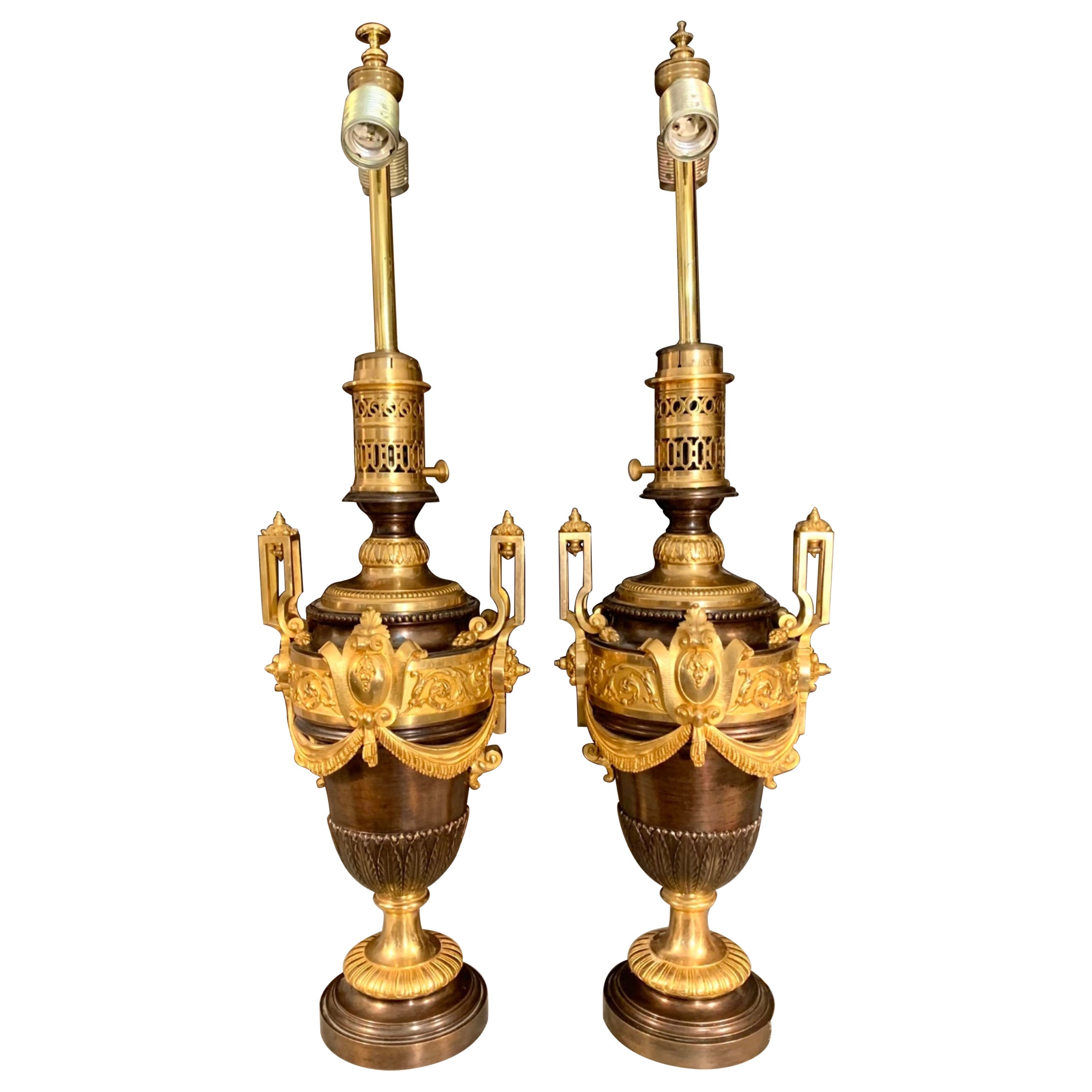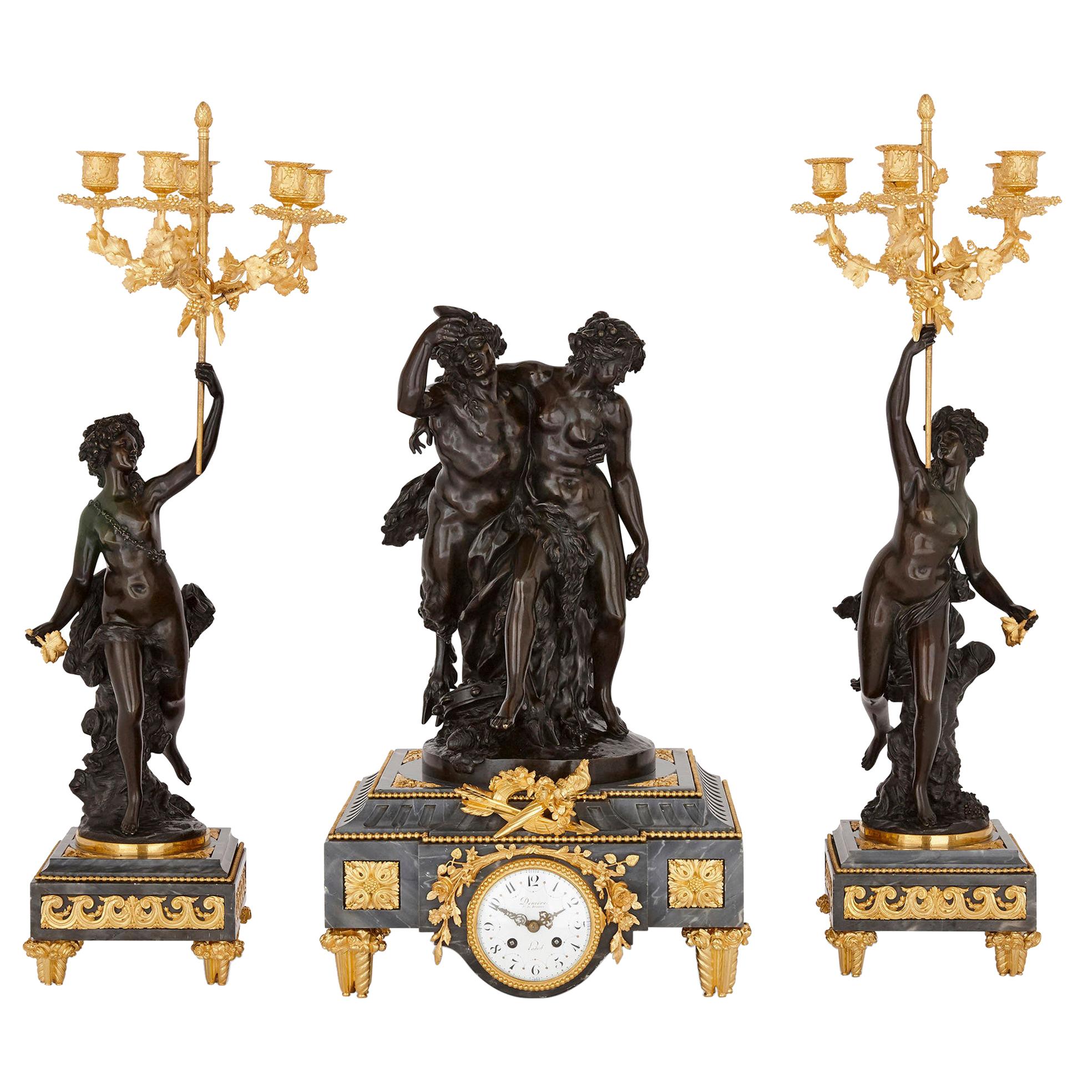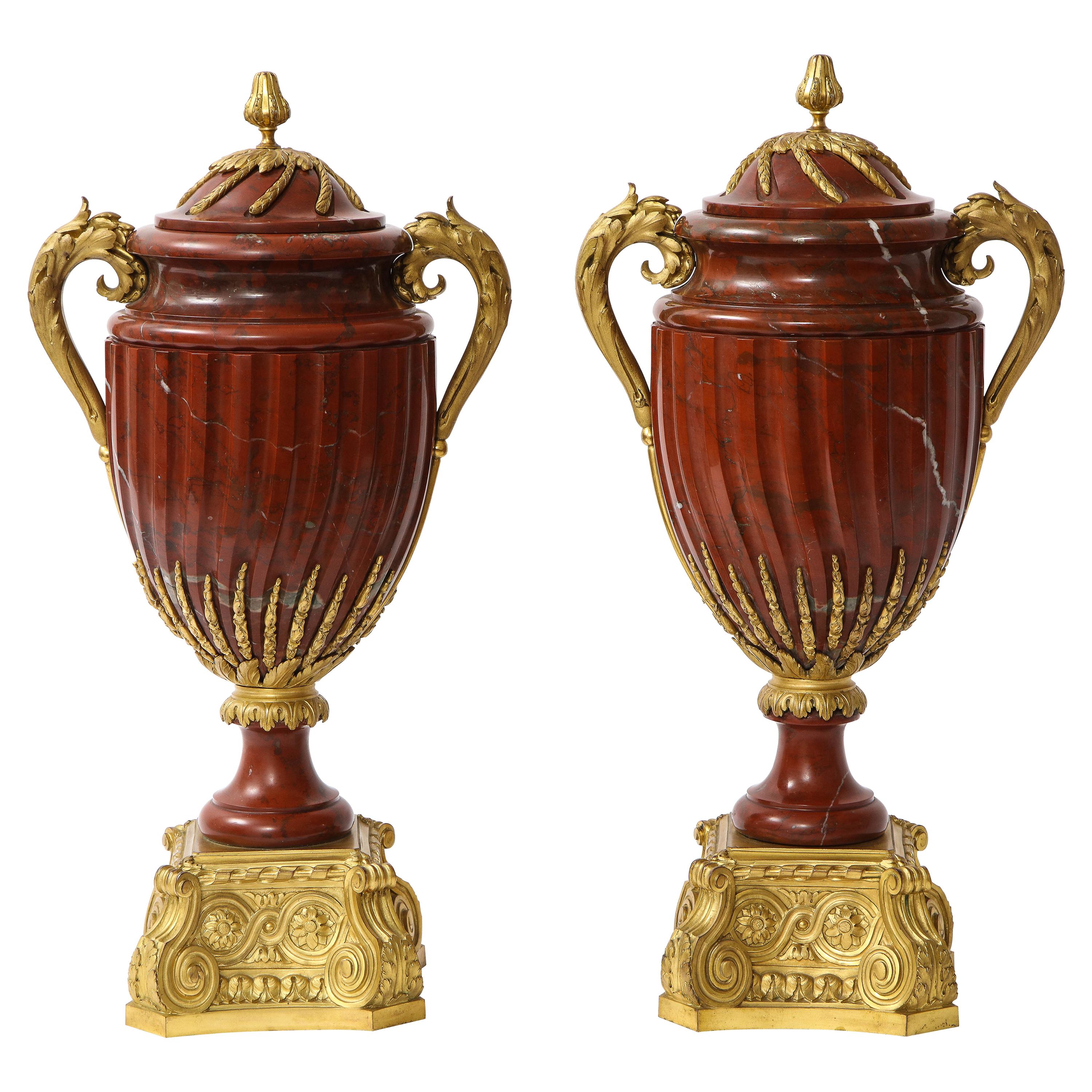Items Similar to French Ormolu and Patinated Bronze-Mounted Marble Vases with Covers by Gagneau
Want more images or videos?
Request additional images or videos from the seller
1 of 11
French Ormolu and Patinated Bronze-Mounted Marble Vases with Covers by Gagneau
About the Item
Our pair of vases with covers by Gagneau of Paris, originally fitted as oil lamps, are modelled as neoclassical maidens supporting vases. Crafted from rouge marble with ormolu bronze mounts. Removeable lids reveal the removeable pierced fittings stamped GAGNEAU.
Gagneau a Paris, also known as Maison Gagneau, of 115 rue Lafayette ci devant B. d'Enghien, is first recorded as operating as early as 1817 with their invention of a mechanical oil lamp. Innovators in lighting, the firm went on to become one of the three great bronze foundries of Paris throughout the nineteenth century, attracting important sculptors such as Ferdinand Levillain, and competing with Barbedienne and Susse Freres. The firm exhibited at world expositions throughout the nineteenth century.
- Dimensions:Height: 28.5 in (72.39 cm)Width: 10.75 in (27.31 cm)Depth: 8.25 in (20.96 cm)
- Materials and Techniques:
- Period:
- Date of Manufacture:circa 1880s
- Condition:Wear consistent with age and use. Each in good condition. There are fine cracks to the marble to top portion of the shoulder. There is minimal rubbing wear to the gilding and oil residue inside each. Lamp hardware missing.
- Seller Location:New York, US
- Reference Number:
About the Seller
No Reviews Yet
Vetted Seller
These experienced sellers undergo a comprehensive evaluation by our team of in-house experts.
Established in 1990
1stDibs seller since 2021
Typical response time: Several days
- ShippingRetrieving quote...Ships From: New York, US
- Return PolicyA return for this item may be initiated within 2 days of delivery.
More From This SellerView All
- Antique Aesthetic Bronze-Mounted Ceramic VaseLocated in New York, USOur very large stoneware vase with polychrome glazed finish in the Aesthetic style measures 21.5 in (54.6 cm) tall and features gilt bronze mounts including berries and a pierced rim...Category
Antique Late 19th Century Aesthetic Movement Vases
MaterialsBronze
- German Rock Crystal and Gilt Brass Coupe with CoverLocated in New York, USOur extraordinary German cup and cover in the Baroque style, circa 1880s, is crafted from gilt brass and features extensive use of rock crystal, including cabochon and faceted circular jewels. Apparently unsigned. Provenance: Koopman Rare Art, London. Regilded and in excellent condition. There is a soldered repair to the female's spear. Founded in London in 1952, Koopman Rare Art is one of the world’s most admired dealers specializing in antique silver, gold and objects de vertu.Category
Antique Late 19th Century German Baroque Revival Vases
MaterialsQuartz, Brass
- 19th Century French Empire Style Ormolu and Patinated Bronze Figural CandelabraLocated in New York, USOur pair of antique (19th century) French ormolu and patinated bronze three-light candelabra are of the highest quality, with neoclassical female figures holding candle arms in the...Category
Antique 19th Century French Empire Revival Candelabras
MaterialsBronze
- Antique Patinated Bronze Hydria Water Jar After the Ancient NeopolitanLocated in New York, USOur antique Grand Tour bronze hydria water jar after the original Greek design, circa 5th century BC, has a verdigris green patina and is finely cast with a winged laughing mask and ...Category
Antique Late 19th Century Italian Neoclassical Revival Jars
MaterialsBronze
- French Ormolu Bronze Table ScreenLocated in New York, USOur ormolu bronze table screen from the early 19th century is unique for its red wax seal depicting an officer on horseback, mounted to brilliant blue gl...Category
Antique Early 19th Century French Empire Fireplace Tools and Chimney Pots
MaterialsBronze
- French Empire Ormolu Bronze Figural SconcesLocated in New York, USOur exceptional pair of gilt bronze Empire period sconces, circa 1810, feature the patinated figures of neoclassical females holding two candle arms with drapery motif, standing upon...Category
Antique Early 19th Century Wall Lights and Sconces
MaterialsBronze
You May Also Like
- French Empire Patinated Bronze, Ormolu and Griotte Marble VaseLocated in London, GBA magnificent quality French Empire/Directoire urn in superb original condition. Constructed of lovely patinated bronze, fire gilded Ormolu and griotte marble. In the gout d'Egypt or...Category
Antique Early 1800s French Empire Urns
MaterialsGriotte Marble, Bronze, Ormolu
- Pair French Patinated Bronze and Ormolu Vases Mounted Table LampsLocated in Madrid, ESA pair of two-handled vases / lamps in classic French Napoleon III style bronze and gilt ormolu of very good quality, each with a foliated plant decoration in bronze, the ormolu orna...Category
Antique Late 19th Century European Napoleon III Table Lamps
MaterialsBronze, Ormolu
- Pair of French Gilt Bronze Ormolu-Mounted Marble VaseLocated in New York, NYPair of ormolu mounted marble vases with ornate gilt bronze leafing and figural mounts framing the urns. France, 19th century. Measures: 20-1/2 in. (52cm) height. NMA Inv. 454Category
Antique 19th Century French Vases
MaterialsMarble, Bronze
- Ormolu and Patinated Bronze Mounted Clock Set by DenièreBy Maison DeniereLocated in London, GBThis clock set contains a mantel clock and a pair of candelabra. The central mantel clock is formed of a rectangular gilt bronze mounted grey marble base. Raised on four gilt bronze ...Category
Antique Late 19th Century French Belle Époque Mantel Clocks
MaterialsMarble, Bronze, Ormolu
- Pair of French Ormolu Mounted Rouge Marble Covered Vases, Signed Maison BoudetLocated in New York, NYAn elaborate pair of French 19th century Louis XVI style ormolu mounted rouge marble covered vases, signed MAISON BOUDET. Each of baluster form, mounted ...Category
Antique 19th Century French Louis XVI Vases
MaterialsGriotte Marble, Bronze
- Pair of Porcelain Vases Ormolu-Mounted in Lamps by Gagneau Paris XIXth CenturyBy Gagneau ParisLocated in Saint-Ouen, FRPair of large Japanese Porcelain Cone Shape Vases with Imari decoration Important mounts in ormolu and gilded metal, the base decorated with a laurel wreath, the upper part of falling leaves and a frieze of knotted ribbon. The mounts signed Gagneau, 115 R. Lafayette. Circa 1860 With their original aluminium bulb cover and original gilding Vase it self Height 47 cm The Gagneau Company is one of the most famous lighting factories in Paris in the nine-teenth century, established in 1800 at 25 rue d'Enghien in Paris and later at 115 rue de Lafayette. She has participated in many exhibitions throughout this century. She began in 1819 with the Exposition des Produits de l'Industrie and later participated in the Universal Exhibitions where she was part of the jury in the category of art bronzes (class 25) at the Universal Exhibition in Paris in 1889. "Imari" was simply the trans-shipment port for Arita wares, from where they went to the for-eign trading outposts at Nagasaki. It was the kilns at Arita which formed the heart of the Japanese porcelain industry. Arita's kilns were set up in the 17th century, after kaolin was discovered in 1616. A popular legend attributes the discovery to an immigrant Korean potter, Yi Sam-Pyeong (1579–1655), although most historians consider this doubtful. After the discovery, some kilns began to produce revised Korean-style blue and white porcelains, known as Early Imari, or "Shoki-Imari". In the mid-17th century, there were also many Chinese refugees in northern Kyushu due to the turmoil in China, and it is said that one of them brought the overglaze enamel coloring technique to Arita. Thus Shoki-Imari developed into Ko-Kutani, Imari, and later Kakiemon, which are sometimes taken as a wider group of Imari wares. Ko-Kutani was produced around 1650 for both export and domestic market.Kutani Ware is characterized by vivid green, blue, purple, yellow and red colors in bold designs of landscapes and nature. Blue and white porcelain pieces continued to be produced and they are called Ai-Kutani. Ko-Kutani Imari for the export market usually adopted Chinese design structure such as kraak style, whereas Ai-Kutani for the domestic market were highly unique in design and are ac-cordingly valued very much among collectors. Ko-Kutani style evolved into Kakiemon-style Imari, which was produced for about 50 years around 1700. Kakiemon was characterized by crisp lines, and bright blue, red and green designs of dramatically stylized floral and bird scenes. Imari achieved its technical and aes-thetic peak in the Kakiemon style, and it dominated the European market. Blue and white Kakiemon is called Ai-Kakiemon. The Kakiemon style transformed into Kinrande in the 18th century, using underglaze blue and overglaze red and gold enamels, and later additional colors. Imari began to be exported to Europe when the Chinese kilns at Jingdezhen were damaged in the political chaos and the new Qing dynasty government halted trade in 1656–1684. Ex-ports to Europe were made through the Dutch East India Company, and in Europe the des-ignation "Imari porcelain" connotes Arita wares of mostly Kinrande Imari. Export of Imari to Europe stopped in mid-18th century when China resumed export to Europe, since Imari was not able to compete against Chinese products due to high labor costs. By that time, however, both Imari and Kakiemon styles were already so popular among Eu-ropeans that the Chinese export porcelain copied both, a type known as Chinese Imari. At the same time, European kilns, such as Meissen and English potteries such as Johnson Bros. and (Royal) Crown Derby, also imitated the Imari and Kakiemon styles. Export of Imari surged again in late 19th century (Meiji era) when Japonism flourished in Europe.Thus, in the western world today, two kinds of true Japanese Imari can...Category
Antique 1880s French Japonisme Table Lamps
MaterialsBronze
Recently Viewed
View AllMore Ways To Browse
Vase With Cover
Covered Marble
Bronze Mount Vase
Ormolu Mount Vase
Ormolu Mounted Vase
Ormolu And Bronze Vases
Patinated Bronze Vase
Bronze Mounted Vase Pair
Vase Pierced
Ormolu French Mounted Vase
Ormolu Mounted Urns
Gold Marble Vase
Urn Bronze Lamp
Neoclassical Bronze Urns
Neoclassical Bronze Urn
Ormolu Mounted Pair Vases
Marble And Gilt Vases
Bronze Ormolu Mounted Vase





